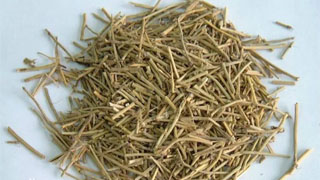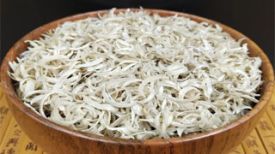
01 aliases: Longsha, Gougu, Beixiang, Beiyan
02 Nature and Taste Meridian: Spicy and slightly bitter in taste, warm in nature; Guilung03 Classification of medicinal materials: plants
04 Medical insurance type: Medical insurance (ephedra, honey ephedra)
05 Indications
Mainly used for external wind cold syndrome, cough and asthma, feng shui edema, wind cold dampness bi, yin gangrene and phlegm nuclei, etc.
06pharmacological action
1. The impact on the central nervous system: Ephedra has an excitatory effect on the central nervous system. The therapeutic dose can excite the cerebral cortex and subcortical center, causing symptoms such as mental excitement and insomnia. Higher doses can cause anxiety and tremors. It can also excite the midbrain, medullary respiratory center, and vascular motor center. Ephedra volatile oil has sweating, analgesic, antipyretic, and cooling effects.
2. The impact on the respiratory system: Ephedrine and pseudoephedrine can alleviate bronchial smooth muscle spasms and have antitussive and anti asthmatic effects. Ephedra volatile oil has a certain expectorant effect.
3. The impact on the cardiovascular system: Ephedrine can enhance myocardial contractility, accelerate heart rate, increase cardiac output, constrict blood vessels, and increase hypertension.
4. Anti pathogenic microbial effects: Ephedra decoction and volatile oil have varying degrees of in vitro inhibitory effects on Staphylococcus aureus, Streptococcus pneumoniae, Diphtheria, Escherichia coli, etc. Volatile oil has a significant inhibitory effect on influenza virus.
5. The impact on the blood system: Ephedra can improve blood rheology, inhibit platelet aggregation, enhance fibrinolysis function, and anticoagulate.
6. In addition, ephedra also has certain effects such as diuresis, diuresis, anti-inflammatory, anti allergic, inhibition of gastrointestinal peristalsis, enhancement of vasoconstriction, dilation of the pupils, diuresis, and reduction of uremic toxins.
07 Clinical Application
1. Wind cold and cold: This product has a spicy and divergent taste, a warm and cold dispelling nature, and mainly enters the lungs and bladder meridians. It is good at promoting lung qi, opening wrinkles, and penetrating hair orifices to sweat and relieve external heat. It has strong sweating power and is an essential medicine for sweating and relieving external heat. It is suitable for the external wind cold syndrome with wind cold and external depression, closed and non sweating of the striae. It is often used in conjunction with cinnamon twigs to enhance the power of sweating, dispersing cold, and relieving external symptoms. Due to the fact that ephedra has the function of relieving asthma, it is particularly suitable for those who have asthma and cough due to excessive wind and cold on the surface, such as ephedra decoction (Treatise on Cold Damage).
2. Cough and wheezing: This product is spicy and bitter, warm and smooth, and mainly enters the lung meridian. It can externally open the skin and hair to promote the circulation of lung qi, and internally lower the ascending and descending qi to restore the normal function of the lungs. Therefore, it is good at relieving asthma and is an essential medicine for treating asthma and cough caused by lung qi obstruction. It is often supplemented by cough and asthma relieving drugs such as almonds. To treat asthma and cough caused by wind cold external bundle and obstruction of lung qi, it is often combined with almonds and licorice, such as San'ao Tang (Taiping Huimin Heju Fang, abbreviated as Heju Fang). For the treatment of cold phlegm and cessation of drinking, coughing and wheezing, and excessive and clear phlegm, it is often combined with herbs such as Asarum, dried ginger, and Pinellia ternata, such as Xiaoqinglong Tang (Treatise on Cold Damage). If the lungs are congested with heat and have high fever and asthma, it is recommended to use plaster, almonds, and licorice in combination to clear the lungs and relieve asthma, such as Ma Xing Gan Shi Tang (Treatise on Cold Damage).
3. Feng Shui Edema: This product promotes lung qi, sweats and relieves external symptoms. It can disperse moisture from the skin's pores, regulate water channels, and lower the bladder to aid in diuresis. Therefore, it is suitable for wind evil to attack the external surface. For edema caused by lung loss and descent, as well as for those with adverse urination and external symptoms, it should be used together with licorice, such as licorice and mahuang decoction (Jin Kui Yao Lue). If combined with drugs such as ginger and Atractylodes macrocephala to relieve sweating and reduce swelling, the therapeutic effect will be better, such as the Yue Mai Jia Shu Tang in the "Golden Chamber Essentials".
4. In addition, the use of Ma Huang San Han Tong Zhi Gong can also be used to treat wind cold Bi syndrome, Yin gangrene, and phlegm nuclei.
08Related discourse
1. The Shennong Classic of Materia Medica: It mainly deals with stroke, typhoid fever, headache, and warm malaria. Sweating, dispelling pathogenic heat, relieving cough and reversing upper qi, dispelling cold and heat, breaking through symptoms and strengthening accumulation.
2. "Compendium of Materia Medica": scattered red swelling and pain, edema, wind swelling Ephedra is a specialized medicine for the lung meridian, so it is commonly used to treat lung diseases. Zhang Zhongjing used ephedra to treat typhoid fever without sweating, and cinnamon twig to treat sweating.
09 Precautions
1. Ephedra should not be used in combination with digitalis like cardiac glycosides to avoid causing ventricular arrhythmias.
2. Ephedra has strong dispersing power and is prone to consuming qi and damaging yin, so the dosage should not be too large.
3. When treating wind cold exterior syndrome, it is best to use it orally; When the symptoms are not obvious and cough and asthma are the main symptoms, honey roasting should be used.
4. Modern pharmacological research has shown that the main component of ephedra is ephedrine, which can enhance myocardial contractility, accelerate heart rate, and increase cardiac output. Patients with severe organic lesions or those receiving digitalis treatment can experience arrhythmia when using ephedra. Therefore, patients with heart disease should be very careful when taking ephedra to prevent overdosing and causing arrhythmia.
5. Ephedrine can excite the central nervous system, with a much stronger effect than adrenaline. High doses can excite the cerebral cortex, brainstem, and medulla oblongata, leading to symptoms such as insomnia, nervousness, anxiety, and tremors. Therefore, attention should be paid not to share with drugs that excite the central nervous system.
6. Ephedra has strong sweating power and is commonly used for wind cold exterior syndrome; Roasted ephedra can relieve sweating and is commonly used for asthma and cough syndrome.
Ephedra, the most commonly used Chinese herbal medicine for sweating and relieving external heat, is spicy, warm, slightly bitter, and belongs to the lung and bladder meridians.
Ephedra is a type of grass called ephedra grass, which has no leaves but only roots and stems. It is mainly cultivated in the northeast and northwest of China. The ephedra we often refer to is its stem, and the root of ephedra is also a medicine, but its effect is exactly the opposite. The root of ephedra is used to store sweat, while the root of ephedra is used to produce sweat. Don't use it wrong.
The Four Major Benefits of Ephedra
Ephedra has four benefits, please take a look and don't remember.
1. Sweating to relieve external heat: The so-called sweating to relieve external heat refers to the release of sweat from the body surface, and the release of evil energy from the body surface with sweat. Why can ephedra sweat? We need to use imagery thinking. Because ephedra is hollow, just like a pipeline, what is the function of a pipeline? One word: Tong. Ephedra can open up the pores of the skin, so it can sweat.
2. dispelling cold and promoting stagnation: The so-called dispelling cold and promoting stagnation refers to dispersing the cold energy that is stagnant on the surface of the body. Why can ephedra disperse cold and promote stagnation? Because ephedra can cause sweating. When the sweat is released, the cold on the surface of the body also comes out. Because ephedra is warm and can dispel cold, the main cause of ephedra powder is cold evil.
3. Promoting lung function and relieving asthma: The so-called promoting lung function and relieving asthma refers to the process of releasing lung qi, allowing it to return to normal levels, and then calming cough and asthma. Why can ephedra promote lung function? The lungs control the skin and hair. Ephedra can open the pores of the skin, which is equivalent to promoting lung qi. The lung qi is originally blocked, and using Ephedra to promote lung qi can help to calm cough and asthma.
4. Promoting diuresis and reducing swelling: The so-called diuresis and reducing swelling, in layman's terms, is to reduce swelling. Why can ephedra reduce edema? The pores of the skin are channels. If this channel is blocked, cold air cannot escape, and water cannot escape. If water cannot escape, it will accumulate under the skin, forming edema. Ephedra can open the pores of the skin and allow water to be discharged from them, which is the principle of Ephedra in reducing edema.
You don't need to remember any of these four effects, you just need to know that ephedra sweats, that's enough. Why can ephedra sweat? Taking an analogy, when you see the hollow shape of ephedra, you naturally think of the "opening" of the pipeline. Ephedra can open pores, so it can sweat. What does it mean? Promote sweating, cold, ventilation, and hydration.
How to use ephedra?
The main function of ephedra is to sweat, and of course, it is used when there is no sweat. Sweating indicates that the pores are open, so do not use ephedra again.
Ephedra sweats and is used to treat superficial symptoms. What is a certificate? Evil energy on the surface of the body is a manifestation. For example, the wind cold bundle on the surface is a manifestation, and ephedra will be used; For example, skin diseases such as urticaria and eczema are also superficial symptoms, and ephedra is also used.
Just remember one thing: Ephedra sweats and is mainly used for treating superficial syndrome.
There are two classic combinations of ephedra:
One is a combination of ephedra and cinnamon twig, which enhances the surface relieving effect of ephedra. For example, Mahuang Tang is a combination of ephedra and cinnamon twig.
Another combination is ephedra mixed with plaster. Mahuang powder can dispel cold on the surface, while plaster can clear lung heat. One dispersion can clear the heat, treating lung heat and high fever with the aim of expelling heat from the lungs.
What should be noted when using ephedra?
1. If there are symptoms of aversion to cold and fear of cold, it indicates that there is indeed cold on the surface, and only then should ephedra be considered.
2. Use ephedra only when there is no sweat; If there is sweat, there is no need for ephedra.
3. Ephedra has a stimulating effect on Yang Qi, which is now said to have an excitatory effect and is prohibited for participating athletes.
4. People who are too weak should be cautious when using ephedra. A person who is too weak is like a deflated balloon that cannot be deflated anymore, so be cautious when using ephedra.
5. Ephedra causes sweating, while its roots accumulate sweat. One yin and one yang have the opposite effect, so never use it incorrectly.
Ephedra has strong sweating power, and the dosage of Ephedra should be small rather than large, usually between 5g and 10g. If it is a child, the dosage should be reduced, and it is recommended to be between 1g and 3g.
Ephedra is a very powerful medicine, but it is a tube drug that most pharmacies cannot buy now, which is not very easy to manage.
The content of the article is for clinical reference only. Non professionals in traditional Chinese medicine are not allowed to try medication.


